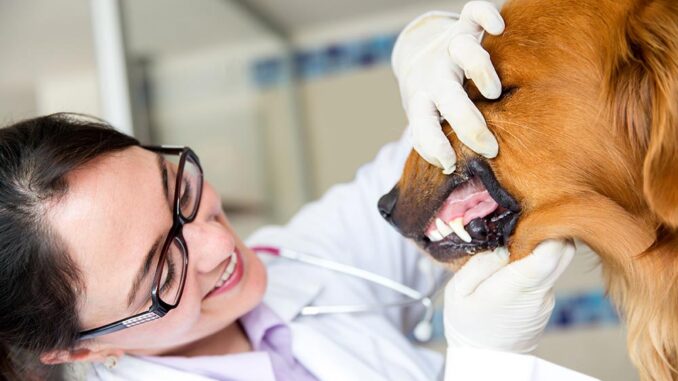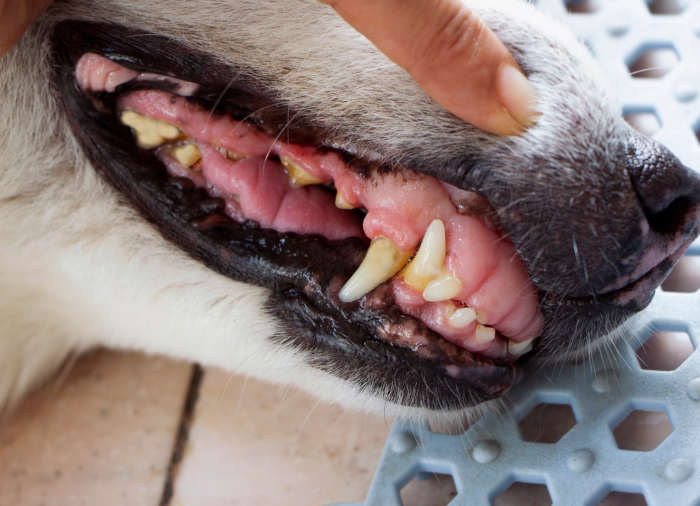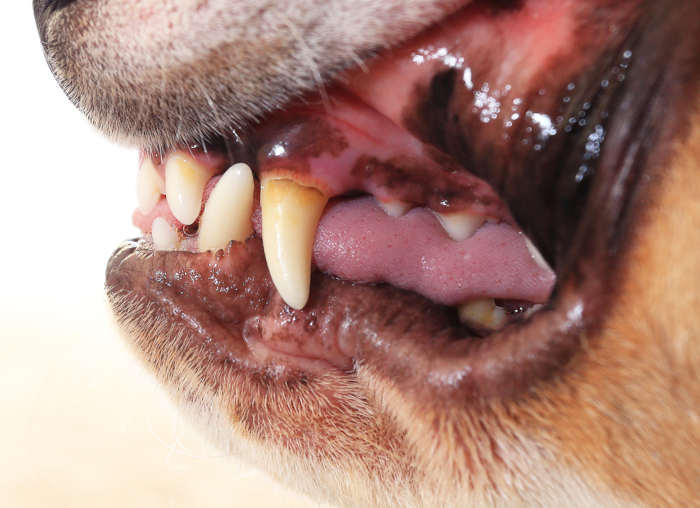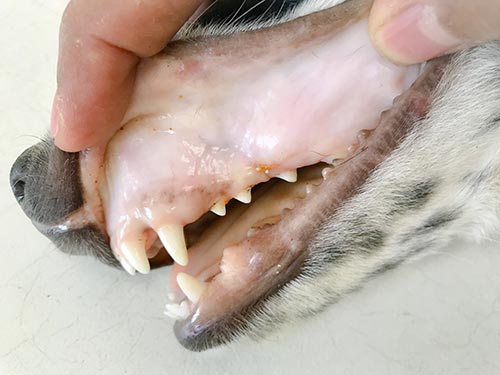
This article was updated on November 14th, 2023
Dehydration in dogs can be a serious issue that dog owners need to be able to recognize as soon as possible. One of the easiest ways to check a dog’s hydration status is by looking at and feeling their gums. In this article, we want to walk you through what normal dog gums look like as well as what gum dehydration in dogs looks like. Then, of course, we’ll look at what to do about it.
What gum dehydration looks like in dogs (with pictures)
You may see some changes in your dog’s gums in the early stages of dehydration, but the most drastic changes come along as that dehydration becomes moderate or severe. Let’s walk through the stages of dehydration and take a look at how the gums may change with each step.
1. Hydrated dog
A dog’s gums are normally a nice pink color and will be wet and slippery to the touch due to the saliva.
Example 1:

Note that some dogs normally have black gums which makes it harder to judge gum color but still possible. Just look for any pink parts for the best visual. Get familiar with what your dog’s gums normally look and feel like so that you can note any differences.
Example 2:

2. Mild dehydration
As a dog starts to lose water, you may notice some lethargy, excessive drooling, and a dry nose. You may also notice that instead of their normal sliminess, gums may start to feel sticky or tacky as the saliva dries out. They won’t have the typical shine and instead may appear drier, as shown on the picture below:

3. Moderate dehydration
As dog’s start to move into moderate dehydration, their gums are going to become drier. They won’t have the normal shine and will feel dry when you touch them. They may also change from a healthy pink to pale and their saliva will become thicker.
Moderately dehydrated dogs won’t want to eat and their skin will remain tented when you pinch the back of their neck instead of snapping back into place.

3. Severe dehydration
When a dog becomes severely dehydrated or has heat stroke, their gums may turn bright red. They will feel dry and their capillary refill time will be prolonged. Capillary refill time is the time it takes for blood to return to the skin after you press a finger into it. A normal capillary refill time is less than two seconds, while a dehydrated dog may be three seconds or longer (as shown on this YouTube video).
A dog’s gums may also lose their smooth appearance as the gums lose moisture and instead be rough-looking or even sunken.
Severely dehydrated dogs may be vomiting, panting excessively, and have sunken eyes as well.
Check out this article in the Whole Dog Journal about the differences between healthy and unhealthy gums: the colors to watch for.
Signs of gum dehydration in dogs
- Pale or white color
- Sticky or tacky texture
- Bright red color
- Dry texture with thick saliva
- Capillary refill time greater than two seconds
- Rough or sunken appearance
6 easy tips to help a dehydrated dog
Any signs of gum dehydration shouldn’t be ignored. Even mild dehydration that goes untreated can lead to serious complications including organ damage and death. So, first thing’s first:
1. Provide fresh, cool water in several locations
It should come as no surprise that dogs prefer clean, fresh water, so make sure to always have some available for them. Set out water bowls in all of the areas that your dog frequents and refill and clean regularly. If your dog still isn’t much interested in water, you may check into a dog water fountain.
- LARGE WATER CAPACITY: 450 oz. water capacity is great for pets of all sizes and multiple pets
2. Offer your dog flavored water or wet food
You can entice drinking by adding a little low-sodium chicken broth or mixing a dab of wet canned food in to make a very watery slurry.
If your dog is mostly eating dry dog food, consider adding canned food to your dog’s diet in order to up fluid intake levels as well.
3. Provide a shady or cool spot
Provide your dog with a shady or cool spot during the summer heat and only exercise during the coolest parts of the day.
4. See if they are interested in crunching ice cubes
A lot of dogs like to crunch on ice, and sometimes when a dog won’t drink, they will lick at ice cubes.
5. Try a syringe
Some dogs will drink from a syringe. They don’t want to drink enough to drink on their own, but their reluctance to drink is not so great that they won’t swallow what is safely placed in their mouth.
6. Check your dog for other signs
Notice if there’s any fever, vomiting, diarrhea, discomfort, etc. If all else is normal, continue to monitor water consumption and push drinking as often as possible.
If the mild signs don’t improve within 12-24 hours or if your pup is showing other issues consult your vet.
When to seek veterinary care
Any sign of dehydration shouldn’t go untreated. While mild cases may be remedied at home, moderate and definitely severe dehydration needs to be seen by a vet. This means that if you notice changes in your dog’s gums, such as paleness or stickiness, it’s time to get an appointment.
If your dog has bright red or dry gums consider it an emergency and get professional care as soon as possible.
How your vet will help
The first thing your vet is going to want to do is get your dog rehydrated. This involves giving fluids either under the skin for milder cases or intravenously for severe cases. While they’re filling your dog’s fluid tank, they will start to diagnose why your dog is dehydrated in the first place.
This may include bloodwork, a urinalysis, and possibly imaging. Any other signs, such as vomiting and diarrhea, will be treated and underlying issues will be addressed as well. Be aware that moderate to severe dehydration in dogs may require hospitalization.
Common causes of gum dehydration in dogs
Many things can cause gum dehydration as well as overall dehydration in dogs. Those include:
Not getting enough water
This cause encompasses many different issues. Dogs may not be getting enough water because it isn’t available to them, they aren’t drinking because they don’t feel well, or they are losing water faster than they can bring it in, such as with vomiting and diarrhea, exertion or heat exhaustion.
You’ll recognize the tell-tale signs of dehydration that we talked about. You may also see other signs of illness or you may see excessive panting with exertion and heat exhaustion. This may be serious depending on the underlying issue.
Fixing it may be as easy as getting your dog some fresh, clean water. If your dog won’t drink, see your veterinarian. They may need to provide fluids and other supportive treatments if a dog is sick or they may need to treat heat exhaustion with fluids and gradually lowering body temperatures.
Illness
When a dog isn’t feeling well because of an infection, eating something they shouldn’t have, or a chronic disease, they may not feel like drinking. Over time, fluid loss will outweigh fluid intake and a dog will become dehydrated. Dogs with a fever or with vomiting and diarrhea may also loss fluids rapidly and won’t be able to compensate by drinking alone.
Either way, dehydration can show up with the typical signs and you may see vomiting, diarrhea, pain, a fever, and not eating. Some dogs may not drink and others may drink excessively depending on the condition.
If your dog is dehydrated, whether they’re drinking or not, see your veterinarian. They can replace those lost fluids and treat other signs with different medications.
Heatstroke
Heatstroke in dogs is a very serious condition that requires immediate veterinary attention. Heatstroke occurs when a dog’s body temperature becomes higher than normal. Dehydration can occur secondary to heatstroke due to excessive panting that causes excessive fluid loss.
Dogs with heatstroke may also show lethargy, incoordination, drooling, panting, disorientation, and seizures. Death can occur.
Treating heatstroke requires gradually cooling a dog down with cool compresses or cool water. You should seek emergency veterinary attention to further safely cool your dog, provide fluids, and other supportive measures.
Disclaimer: This website's content is not a substitute for veterinary care. Always consult with your veterinarian for healthcare decisions. Read More.



Be the first to comment